Private LTE Market Size
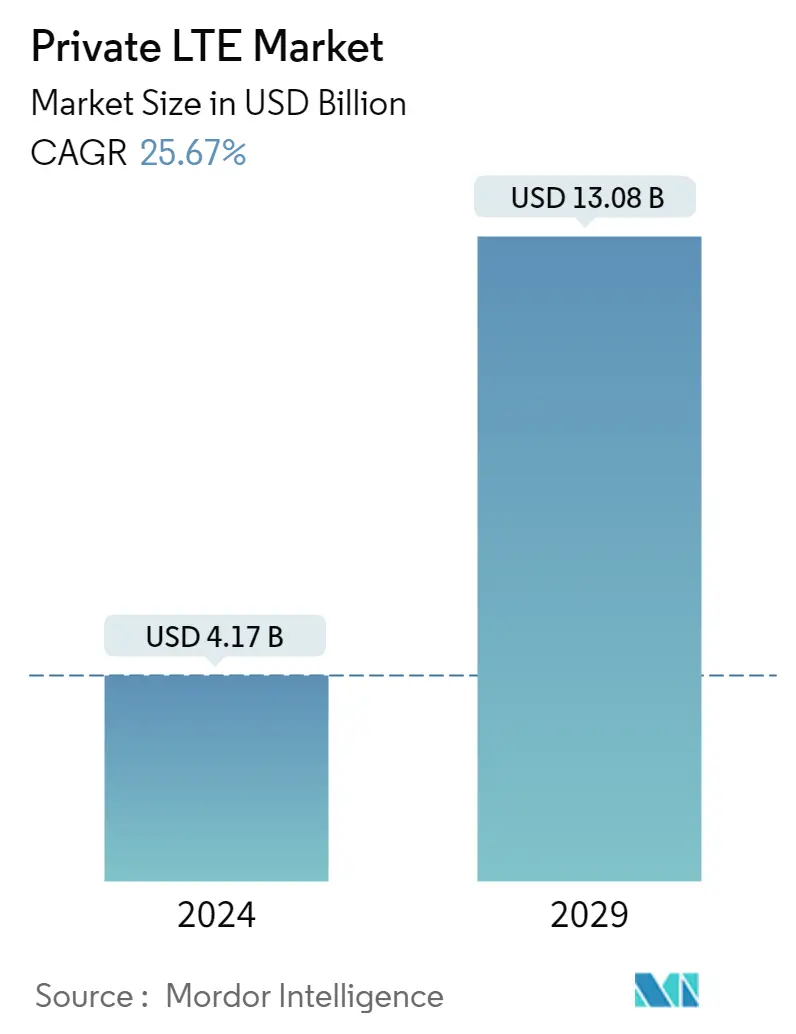
| Study Period | 2019 - 2029 |
| Market Size (2024) | USD 4.17 Billion |
| Market Size (2029) | USD 13.08 Billion |
| CAGR (2024 - 2029) | 25.67 % |
| Fastest Growing Market | Asia-Pacific |
| Largest Market | North America |
Major Players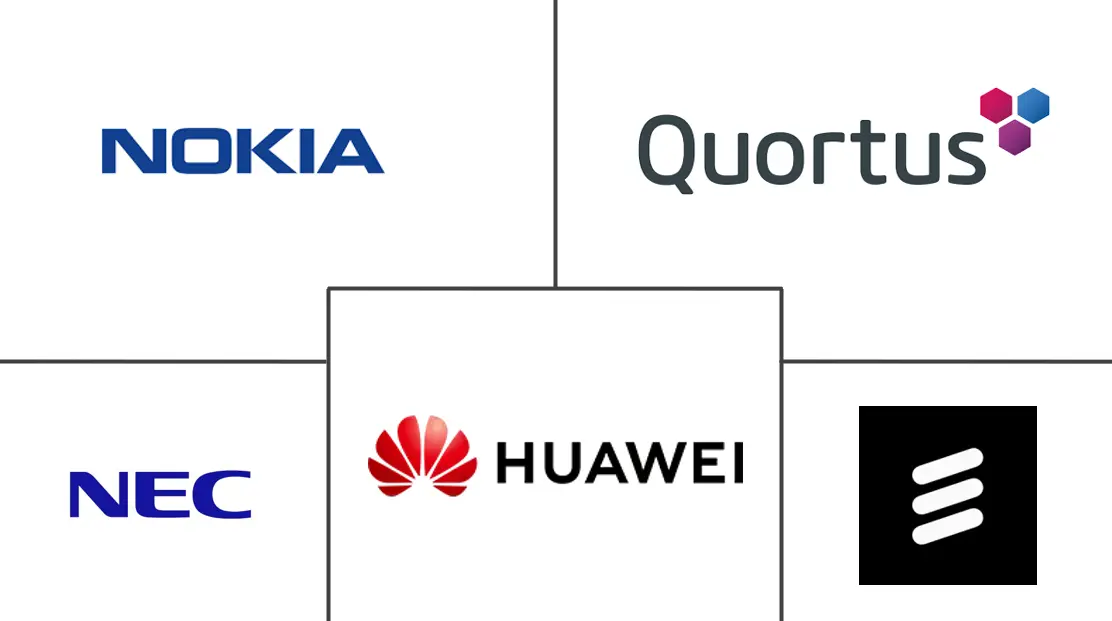
*Disclaimer: Major Players sorted in no particular order |
Private LTE Market Analysis
The Private LTE Market size is estimated at USD 4.17 billion in 2024, and is expected to reach USD 13.08 billion by 2029, growing at a CAGR of 25.67% during the forecast period (2024-2029).
The availability of unlicensed spectrums like CBRS and MulteFire bands, as well as the growing adoption of private LTE networks, enable consumers to improve situational awareness, obtain more accurate information, and speed up response times. These factors are anticipated to contribute to the market's rapid growth throughout the forecast period.
- The development of private LTE networks is a result of the expanding need to convert heterogeneous, disconnected networks into smart linked systems in order to provide better customer contact and service delivery methods. Additionally, a private LTE network eliminates the limitations of a traditional network system, like Ethernet or Wi-Fi, by enabling both human and machine communication on a single network.
- The potential for a private LTE/5G network is gaining a lot of attention from suppliers, including infrastructure providers and mobile carriers, as well as from business purchasers across various industries. A vast number of applications and use cases are made possible by private LTE/5G networks, which can replace or supplement traditional network technologies.
- The widespread use of isolated systems is a primary factor driving private LTE networks. Private LTE networks provide benefits such as high speed, high capacity, high security, low latency, consistent performance, more extended range, and interoperability that support the demand necessary to achieve IIoT. The abovementioned factors are critical elements significantly affecting the private LTE market.
- Moreover, the automation Industry uses private LTE networks for various applications such as factory-floor robotics and logistics and warehousing (for pick and pack machines). Factory-floor robotics, logistics, and warehouse divisions also use private LTE. Due to these networks' growing advantages, they are increasingly being deployed for other users, such as transportation, mining, and enterprise IIoT applications.
- However, the specifications for private LTE/5G networks are complicated and highly individualized, making it challenging to expand the industry. Further, factors hindering the growth of private LTE are the complexity associated with implementing private LTE networks and constraints in terms of the requirement for an authorized license to deploy a private LTE network.
- COVID-19 had a mixed impact on the LTE market. In the initial stages of the epidemic, the market witnessed a decline in smartphone demand and reduced deployment of cell towers. However, in the further stages of the pandemic, the work-from-home culture and social distancing norms created a significant demand for the overall LTE market, especially private LTE, thereby witnessing rapid positive growth.
Private LTE Market Trends
Growing Adoption of Smartphones may Drive the Market Growth
- The growing adoption of smartphones has increased global data usage on a per-person basis, increasing the need for LTE services and driving the industry. The World Population Review reported that 4.9 billion people, or 69% of the world's population, will be actively using the internet by 2022. According to trends, the number of internet users is increasing at a 4% yearly pace, which amounts to over 196 million additional users joining the network yearly.
- Further, according to GSMA, the global smartphone adoption rate was around 75% last year and is anticipated to reach 84% by 2025. Such significant growth rates could increase the opportunities for various LTE providers to meet the growing requirement.
- Smartphones have altered internet usage patterns and increased everyone's access to the online world. Global smartphone usage increased by 268 million people alone between 2021 and 2022. In only five years, the percentage of internet usage on mobile devices has increased from 43.7% to 55%, owing to the rise in smartphone users. By 2025, it is anticipated that 72.6% of smartphone users will solely use their phones to access the internet. Such significant growth in smartphone adoption could drive the market during the forecast period.
- The global expansion of smartphones has increased data traffic, putting additional strain on the communication infrastructure. As a result, 4G (LTE) network upgrades have become necessary for telecommunication service providers in order to guarantee capacity and satisfy customer needs at reasonable prices. Accordingly, these factors would further drive market expansion during the projection period.
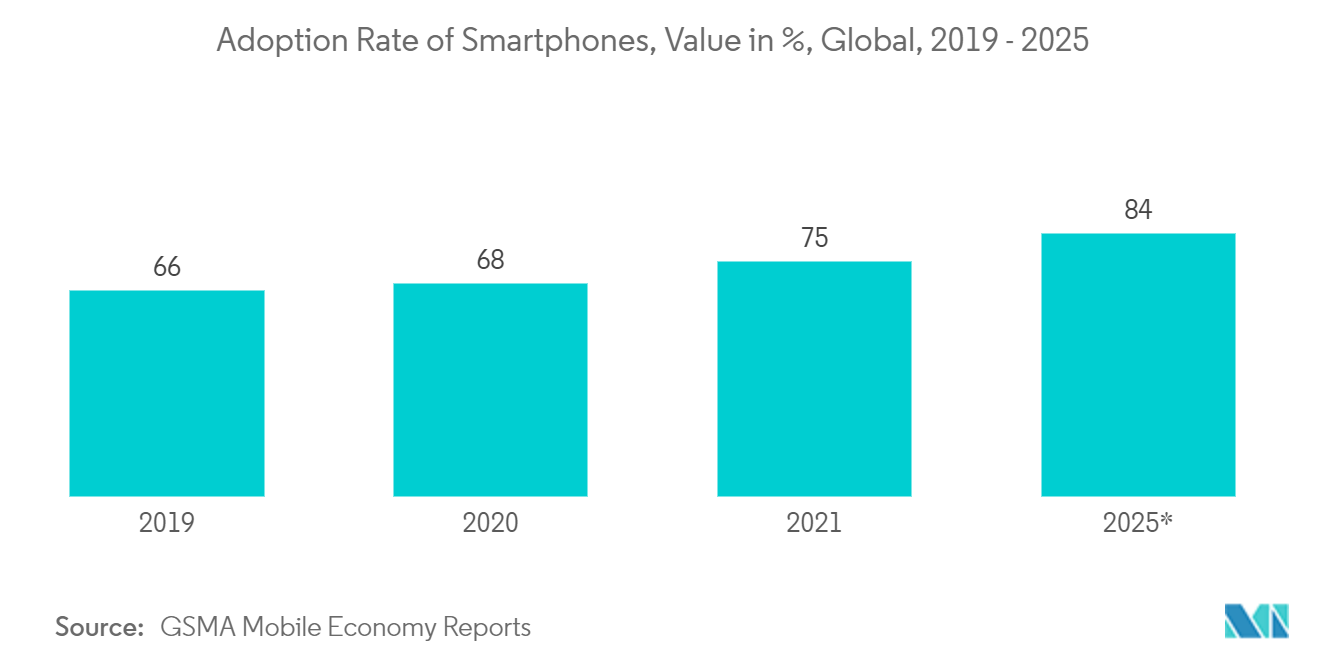
Asia-Pacific Expected to Hold Significant Growth Rates
- The Asia-Pacific region is predicted to generate new market prospects for private LTE network vendors. Japan, China, and Australia are significant nations in APAC considering the expansion of the private LTE market.
- China and Japan are prominent manufacturing nations that create electronic, informational, and automotive goods. The surge in M2M communications, greater smartphone use, and the uptake of IoT platforms across a variety of industrial verticals, including healthcare, transportation, and manufacturing, are all contributing factors to the market expansion of private LTE in this area. The need for private IoT networks that allow businesses to integrate various devices for better dependability and security is growing as a result.
- The need for the private LTE market is considerably driven by the growing deployment of Industry 4.0, industrial IoT, and automated technologies. The primary factor positively affecting the market is connectivity's ongoing development. The increasing number of linked devices in the industrial industry produces enormous data. This data must be adequately processed to ensure efficient company operations. The rising economies of scale that drive the adoption of private LTE across the industry have been made possible by the expanding investments in machine-to-machine (M2M) and classical IoT.
- The region is predicted to witness significant growth rates throughout the projection period due to its robust economic growth and continued telecom industry development, encouraging businesses to actively invest in private LTE to maintain growth and boost productivity. Additionally, factors like the significant shift toward digital drive market growth.
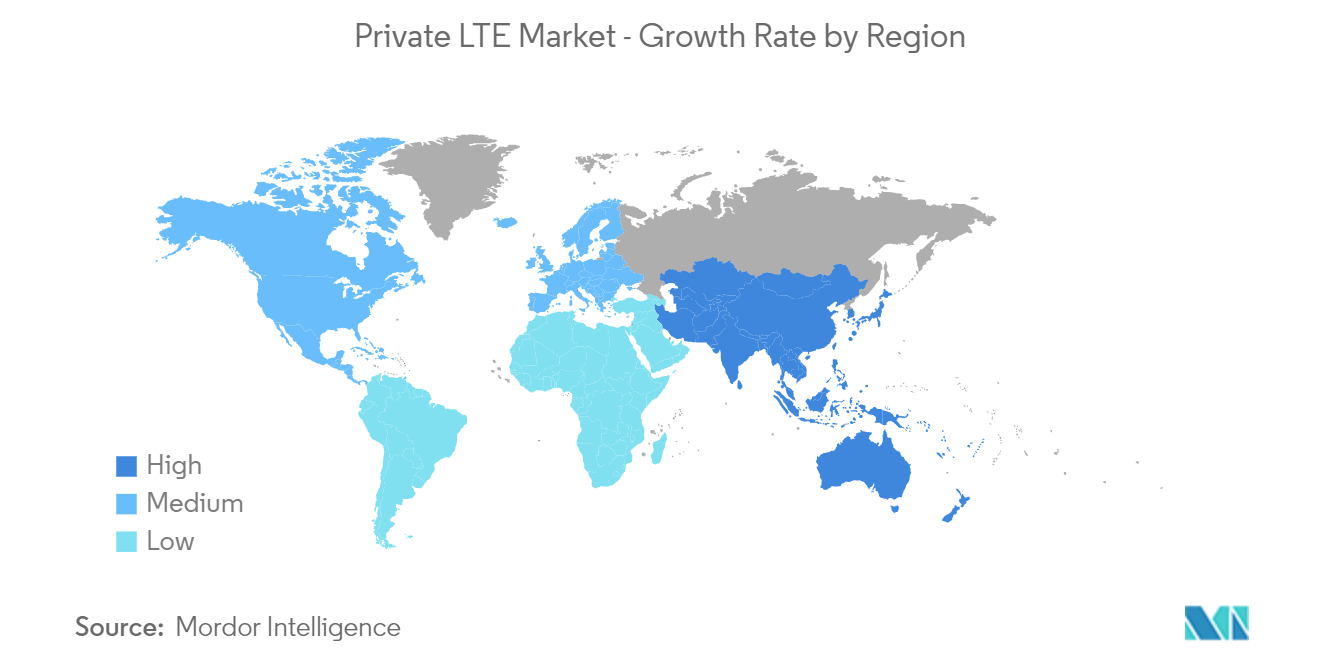
Private LTE Industry Overview
The Private LTE market is consolidated, and it is dominated by a few significant shareholding players present in the market. The market witnessed various mergers and acquisitions of smaller firms by the larger firms, thereby consolidating the market, which often makes it difficult for new entrants to enter and compete in the market, along with larger firms accounting for considerable network expansions globally. A few of the significant market players include Nokia Corporation, Quortus Limited, LM Ericsson Telephone Company, Huawei Technologies Co., Ltd., and NEC Corporation.
In November 2022, Betacom, a provider of network design and services, partnered with Qualcomm to link its private LTE/5G network design and management service with Qualcomm's RAN automation and management offering, as well as a ready pool of Qualcomm-approved deployment partners for enterprise customers in the Industry 4.0 space. This partnership aims to provide clients with access to an end-to-end, off-the-shelf private network solution that has been thoroughly tested and verified and is supported by knowledge and assistance.
In July 2022, Aviat Networks, Inc., an industry player in wireless transport solutions, and Redline Communications Group Inc., a prominent supplier of mission-critical data infrastructure, announced that the acquisition of Redline by a subsidiary of Aviat had been completed following a statutory plan of arrangement under the Canada Business Corporations Act. As a result, Aviat can now provide its clients with an integrated end-to-end offering for wireless access and transport.
Private LTE Market Leaders
-
Nokia Corporation
-
Quortus Limited
-
LM Ericsson Telephone Company
-
Huawei Technologies Co., Ltd.
-
NEC Corporation
*Disclaimer: Major Players sorted in no particular order
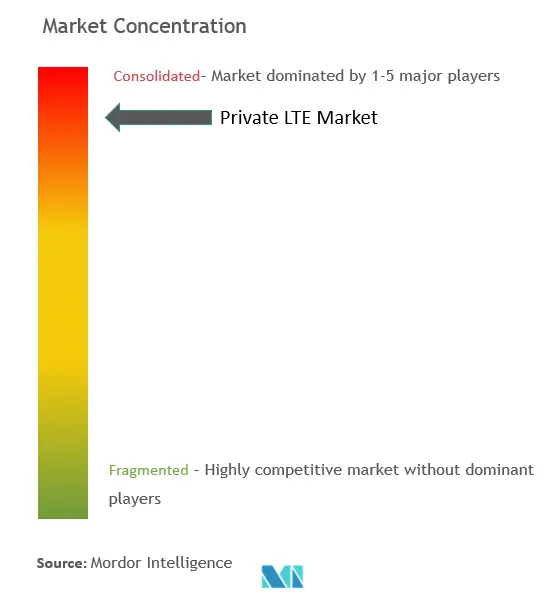
Private LTE Market News
- February 2023: Vocus, a fiber and network solutions provider, signed to acquire Challenge Networks, an Australian provider of telecommunications services. The addition of wireless network capability completes Vocus' USD 1 billion investment strategy, which also includes the deployment of significant new fiber infrastructure, including the Horizon and Highclere projects in the northwest of Australia, as well as capacity upgrades to the company's current network.
- May 2022: NTT Ltd., a prominent global technology services provider, announced that it is partnering with Albemarle Corporation, a specialty chemicals company, to deploy a pilot private LTE/5G and Wi-Fi network at Albemarle's lithium mine in Kings Mountain, North Carolina. Albemarle required a network enabling its international engineers to interact with technicians for remote site scans and assistance since it operated mining and manufacturing plants spanning three continents.
Private LTE Market Report - Table of Contents
1. INTRODUCTION
- 1.1 Study Assumptions and Market Definition
- 1.2 Scope of the Study
2. RESEARCH METHODOLOGY
3. EXECUTIVE SUMMARY
4. MARKET INSIGHTS
- 4.1 Market Overview
- 4.2 Industry Value Chain Analysis
-
4.3 Industry Attractiveness - Porter's Five Forces Analysis
- 4.3.1 Bargaining Power of Suppliers
- 4.3.2 Bargaining Power of Buyers/Consumers
- 4.3.3 Threat of New Entrants
- 4.3.4 Threat of Substitute Products
- 4.3.5 Intensity of Competitive Rivalry
- 4.4 Assessment of the Impact of COVID-19 on the Market
5. MARKET DYNAMICS
-
5.1 Market Drivers
- 5.1.1 Increasing Adoption of Isolated Systems
- 5.1.2 Growing Adoption of Smartphones
-
5.2 Market Challenges
- 5.2.1 Requirements for Authorized License
- 5.2.2 High Deployment Costs and Frequency Band Interference
6. TECHNOLOGY SNAPSHOT
7. MARKET SEGMENTATION
-
7.1 By Component
- 7.1.1 Infrastructure
- 7.1.2 Services
-
7.2 By Technology
- 7.2.1 Frequency-Division Duplexing (FDD)
- 7.2.2 Time Division Duplex (TDD)
-
7.3 By Deployment
- 7.3.1 Centralized
- 7.3.2 Distributed
-
7.4 By Frequency Band
- 7.4.1 Licensed
- 7.4.2 Unlicensed
- 7.4.3 Shared Spectrum
-
7.5 By End-user Industry
- 7.5.1 Industrial (Public Safety, Supply Chain Management, Utilities, Manufacturing)
- 7.5.2 Healthcare
- 7.5.3 Enterprise
- 7.5.4 Other End-user Industries
-
7.6 Geography
- 7.6.1 North America
- 7.6.1.1 United States
- 7.6.1.2 Canada
- 7.6.2 Europe
- 7.6.2.1 Germany
- 7.6.2.2 United Kingdom
- 7.6.2.3 France
- 7.6.2.4 Rest of Europe
- 7.6.3 Asia-Pacific
- 7.6.3.1 China
- 7.6.3.2 Japan
- 7.6.3.3 India
- 7.6.3.4 Rest of Asia-Pacific
- 7.6.4 Rest of the world
8. COMPETITIVE LANDSCAPE
-
8.1 Company Profiles
- 8.1.1 Nokia Corporation
- 8.1.2 Quortus Limited
- 8.1.3 LM Ericsson Telephone Company
- 8.1.4 NEC Corporation
- 8.1.5 Luminate Wireless Inc.
- 8.1.6 Huawei Technologies Co., Ltd.
- 8.1.7 Qualcomm Technologies, Inc.
- 8.1.8 Future Technologies Pvt. Ltd.
- 8.1.9 Sierra Wireless Inc.
- 8.1.10 Redline Communications Group Inc. (Aviat Networks, Inc.)
- 8.1.11 Ruckus Networks Inc.
- *List Not Exhaustive
9. INVESTMENT ANALYSIS
10. MARKET OPPORTUNITIES AND FUTURE TRENDS
** Subject To AvailablityPrivate LTE Industry Segmentation
A private LTE network can be defined as a network that can cover a scaled-down version of a public cellular network using tiny cells, which are theoretically comparable to Wi-Fi access points. The market for the study defines the revenues accrued from the sales of LTE services offered by various vendors across multiple end-users, including Industrial (Public Safety, Supply Chain Management, Utilities, Manufacturing), Healthcare, and Enterprise.
The Private LTE Market is segmented by Component (Infrastructure, Services), Technology (Frequency-Division Duplexing (FDD), Time Division Duplex (TDD)), Deployment (Centralized, Distributed), Frequency Band (Licensed, Unlicensed, Shared Spectrum), End-user Industry (Industrial Public Safety, Supply Chain Management, Utilities, Manufacturing), Healthcare, and Enterprise) and Geography (North America, Europe, Asia-Pacific, and Rest of the World).
The market sizes and forecasts are provided in terms of value (USD million) for all the above segments.
| By Component | Infrastructure | |
| Services | ||
| By Technology | Frequency-Division Duplexing (FDD) | |
| Time Division Duplex (TDD) | ||
| By Deployment | Centralized | |
| Distributed | ||
| By Frequency Band | Licensed | |
| Unlicensed | ||
| Shared Spectrum | ||
| By End-user Industry | Industrial (Public Safety, Supply Chain Management, Utilities, Manufacturing) | |
| Healthcare | ||
| Enterprise | ||
| Other End-user Industries | ||
| Geography | North America | United States |
| Canada | ||
| Geography | Europe | Germany |
| United Kingdom | ||
| France | ||
| Rest of Europe | ||
| Geography | Asia-Pacific | China |
| Japan | ||
| India | ||
| Rest of Asia-Pacific | ||
| Geography | Rest of the world |
Private LTE Market Research FAQs
How big is the Private LTE Market?
The Private LTE Market size is expected to reach USD 4.17 billion in 2024 and grow at a CAGR of 25.67% to reach USD 13.08 billion by 2029.
What is the current Private LTE Market size?
In 2024, the Private LTE Market size is expected to reach USD 4.17 billion.
Who are the key players in Private LTE Market?
Nokia Corporation, Quortus Limited, LM Ericsson Telephone Company, Huawei Technologies Co., Ltd. and NEC Corporation are the major companies operating in the Private LTE Market.
Which is the fastest growing region in Private LTE Market?
Asia-Pacific is estimated to grow at the highest CAGR over the forecast period (2024-2029).
Which region has the biggest share in Private LTE Market?
In 2024, the North America accounts for the largest market share in Private LTE Market.
What years does this Private LTE Market cover, and what was the market size in 2023?
In 2023, the Private LTE Market size was estimated at USD 3.32 billion. The report covers the Private LTE Market historical market size for years: 2019, 2020, 2021, 2022 and 2023. The report also forecasts the Private LTE Market size for years: 2024, 2025, 2026, 2027, 2028 and 2029.
Private LTE Industry Report
Statistics for the 2023 Private LTE market share, size and revenue growth rate, created by Mordor Intelligence™ Industry Reports. Private LTE analysis includes a market forecast outlook to 2029 and historical overview. Get a sample of this industry analysis as a free report PDF download.



